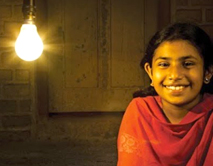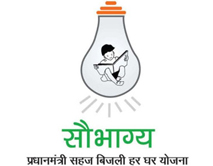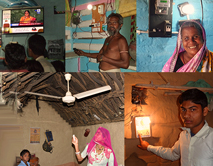
Pradhan Mantri Sahaj Bijli Har Ghar Yojana - Saubhagya is to provide energy access to all by last mile connectivity and electricity connections to all remaining un-electrified households in rural as well as urban areas to achieve universal household electrification in the country.
The electricity connection to households include release of electricity connections by drawing a service cable from the nearest pole to the household premise, installation of energy meter, wiring for a single light point with LED bulb and a mobile charging point. In case the electricity pole is not available nearby from household for drawing service cable, the erection of additional pole along with conductor and associated accessories shall also be covered under the scheme.
The Prime Minister, Shri Narendra Modi launched the Pradhan Mantri Sahaj Bijli Har Ghar Yojana - Saubhagya, at Deendayal Urja Bhawan, in New Delhi on September 25, 2017.
The total outlay of the project is Rs. 16, 320 crore while the Gross Budgetary Support (GBS) is Rs. 12,320 crore. The outlay for the rural households is Rs. 14,025 crore while the GBS is Rs. 10,587.50 crore. For the urban households the outlay is Rs. 2,295 crore while GBS is Rs. 1,732.50 crore. The Government of India will provide largely funds for the Scheme to all States/UTs.
The States and Union Territories are required to complete the works of household electrification by the 31st of December 2018.

- Access to electricity to all willing households
- Substitution to Kerosene
- Improvement in Health Services
- Improvement in Communications
- Improvement in Public Safety
- Increased Job Opportunities
- Better Quality of Life, especially for Women, in Daily Chores
Highlights of the Saubhagya Electricity Scheme
- The scheme is launched on the occasion of the birth centenary celebration of Pandit Deen Dayal Upadhyaya on 25th September.
- Scheme aims to achieve 24x7 power for all by 2019 by providing electricity connection to each household across the country.
- Scheme will provide subsidy on equipment such as transformers, wires and meters.
- Ministry of Power would be the implementing authority of the scheme.
- Power connection will be provided in both rural and urban areas of the country.

For easy & accelerated implementation of the Scheme , modern technology shall be used for household survey by using Mobile App. Beneficiaries shall be identified and their application for electricity connection along with applicant photograph and identity proof shall be registered on spot. The Gram Panchayat/Public institutions in the rural areas may be authorised to collect application forms along with complete documentation, distribute bills and collect revenue in consultation with the Panchayat Raj Institutions and Urban Local Bodies. The Rural Electrification Corporation Limited (REC) will remain the nodal agency for the operationalisation of the scheme throughout the country.
Distribution Sector
Deendayal Upadhyaya Gram Jyoti Yojana (DDUGJY) envisage creation of basic electricity infrastructure in villages / habitations, strengthening & augmentation of existing infrastructure, metering of existing feeders / distribution transformers / consumers to improve quality and reliability of power supply in rural areas. Besides this, last mile connectivity and free electricity connections are also provided to BPL households only identified by the States as per their list. However, in villages which are electrified in past for a long period, many households do not have electricity connections for many reasons. Some of the really poor households do not have BPL cards but these households are not capable of paying applicable initial connection charges. There is also lack of awareness as to how to get connection or taking connection is not an easy task for illiterate people. There may not be electricity pole nearby and the cost of erection of additional pole, conductor is also chargeable from the households for obtaining a connection.
Similarly in urban areas, Integrated Power Development Scheme (IPDS) provides for creation of necessary infrastructure to provide electricity access but some households are not yet connected mainly on account of their economic condition as they are not capable of paying the initial connection charges.
Therefore, Soubhagya has been launched to plug such gaps and comprehensively address the issues of entry barrier, last mile connectivity and release of electricity connections to all un-electrified households in rural and urban areas.

Access to electricity definitely has positive impact on quality of life of people in all aspects of daily household chores and human development. At the first place, access to electricity would substitute uses of Kerosene for lighting purposes resulting in reduction in indoor pollution. Reduction in indoor pollution will save people from health hazards. Further, electricity access would help in establishing efficient and modern health services in all parts of the country. Lighting after the sunset also provide a sense of enhanced personal safety especially for women and increase in post sunset social as well as economic activities. Availability of electricity will boost education services across all areas and quality lighting post sunset would facilitates children to spend more time on studies and move ahead further in prospective careers. Household electrification also increases the likely hood that women would study and earn income.
Economic Growth and Employment Generation
Substitution of use of Kerosene with electricity for lighting purposes would reduce annual subsidy on Kerosene and would also help reduce the import of petroleum products. Electricity in each home would provide improved access to all kind of communications like Radio, Television, Internet, mobile etc. through which everyone would be able to access all kind of important information available through these communication mediums.Farmers can access information about new and improved agriculture techniques, agro-machinery, quality seeds etc. resulting in significant increase in agriculture production and consequently increase in income. Farmers and youths can also explore the possibilities of setting up agro based small industries.
Availability of reliable electricity services would also facilitate establishment of new shops of daily use goods, fabrication workshops, flour mills, cottage industries etc. and such economic activities would generate direct as well indirect employment. Implementation of scheme itself would result into employment generation in view of the requirement of semi-skilled / skilled manpower for execution of works of household electrification. About 1000 lakh man-days works would be generated for implementation of the scheme.
Related Links





